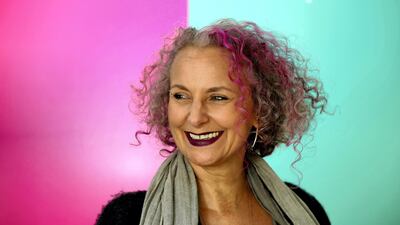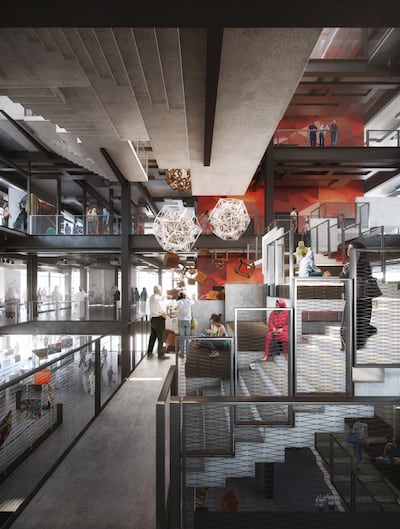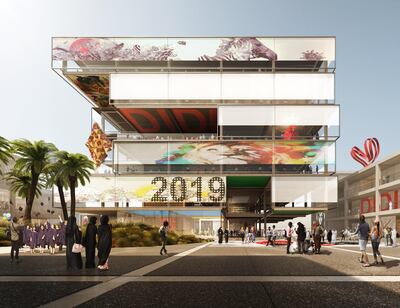With her pale green eyes, purple lipstick, inked arms and
unruly grey curls interspersed with hot pink highlights, Sass Brown looks every bit as formidable as her name might suggest.
She may have just been appointed as the founding dean of the Dubai Institute of Design and Innovation (DIDI), the first private, not-for-profit design university in the UAE, but Brown is the direct antithesis of your stereotypical staid, stuffy academic. She is, if you'll excuse the fashion speak, utterly fabulous.
A veteran of New York's Fashion Institute of Technology (FIT), Brown is the author of two books on ethical fashion, and, crucially, started her career as a fashion designer, so has actual, hands-on industry experience. Which all means that she is uniquely positioned to recognise the level of disruption currently coursing through the design world.
"Traditional systems are breaking down," she says. "The system has always been seen as sacrosanct – as a designer, this is what you do, no questions asked; you must produce in this way, it must be thematic, it must be seasonal, it must be delivered on these timelines, or else you won't sell. But look at how we have moved away from the traditional system of building a single collection, months in advance, and showing it at a private, industry-only fashion show, in January, for a summer delivery. That whole system has been breaking down. You can see it in the big brands, like Burberry, showing direct to the consumer. You can see it in the growth of the importance of the internet, and of bloggers.
"There is a lot more democratic-type design and cross-disciplinary design going on. And things like crowdfunding, which have a direct influence on the evolution of product and whether it even gets produced."
As a result, the future of design will be a lot more diverse – and a lot less predictable – than it has been in the past. "It is no longer a single system. There are so many things going on. That's the complexity and the challenge – but it's also the cool bit," Brown says with a wide smile. "There's so much opportunity."
She points to tiny, regional, emerging designers – in Valparaíso, Chile, or Manchester, England – who have been stomping on the status quo. "Now it's trickling up and getting to a tipping point, so that more and more people are aware of it, and more and more brands are taking those ideas and philosophies onboard."
As the author of Eco Fashion and ReFashioned, the United Kingdom-born Brown is a huge proponent of sustainability, but does not necessarily reject the fast-fashion model in its entirety. "Fast fashion may not be a bad thing if, once you've discarded that piece, it can be put right back into the system as raw materials to produce the next thing. That's not a horrible thing. It's the discarding of the product at the end of it that is the issue," she says.
It is notable that, although she started out as a designer, Brown became disenfranchised with the industry almost two decades ago. "I became frustrated with the business and the commerce of design, and its focus on past analytics. Stripes sold, therefore, we are going to do stripes again – as opposed to what was new and fresh. So I started teaching a single course at FIT in New York."
She found that academia welcomed parts of her that were not particularly welcome in the corporate world. "My individuality, my own expressiveness, my own interests in sustainability. It allowed me a huge growth spurt, to really develop into sustainable thinking and how technology relates to that."
And, after 17 illustrious years at FIT, one of the most highly regarded fashion institutes in the world, what was it about this job – a brand-new role at a university that is still in its planning stages – that appealed to her?
"It offers an opportunity that is very rare in academic circles," says Brown. "In established universities, you are very restricted in what you can and can't do by many, many years of established protocols, policies, procedures, most of which, particularly in older universities, have been built to protect the disciplines. We have this really rare opportunity to design a design school," she says. To do this, DIDI has joined forces with Massachusetts Institute of Technology and Parsons School of Design, which according to Brown are "two world-class, forward-thinking institutions, both renowned for using design as problem-solving".
Parsons, in particular, is known "for doing fashion as problem-solving, rather than fashion just because it's pretty, or fashion purely for consumption". DIDI will offer the region's first Bachelor of Design degree and welcome its initial intake of students in autumn 2018, with about 130 students expected in the opening year. This figure is expected to grow to about 550 once the university is fully operational.
As curriculum partners, MIT and Parsons have worked closely with DIDI to create an educational programme that eschews a traditionally siloed approach and instils a more cross-disciplinary mindset. After all, the modern-day fashion designer is rarely just a fashion designer, and a product design seldom focuses purely on furniture. So they might delve into wearables, dabble with interiors, come back to fashion, and then branch off into a bit of branding.
To this effect, students will start their careers at DIDI with a design foundation that is more "technology-based and forward-thinking" than traditional art and design foundation courses. Based around design thinking and creative challenges, it will offer exposure to various industries.
Students will then choose from five concentrations: product design, strategic design management, media, visual arts, and fashion design. But instead of focusing on one single concentration, students have to choose two. Teaching will focus on a studio-centric "learning-by-making" model.
All of this will take place in Dubai Design District – initially within Building 4, and then in a custom-designed Foster and Partners building on the grounds on d3 that is set for completion in summer 2019.
"The building is based on deep research on the future of education and learning, and what the best schools are doing in terms of layout. Everything is open and movable and modular, so there's no separation between departments. And there's a huge mega-studio where students from all five disciplines will be working together in a single space," explains Brown.
Perhaps most importantly of all, the DIDI curriculum acknowledges that design no longer sits on the fringes of industry – it is a key focus of any entity hoping to achieve success in this day and age.
"Design has never been a more important component of businesses that traditionally don't think of themselves in creative ways," Brown points out. "There is certainly no longer a question of the value of design in most companies or corporations. Whether you are a Unilever or a Burberry or everything in between, the value of design is unquestionable."
And yet, as Brown acknowledges, the careers that DIDI's students will graduate into don't even exist yet. So how does one prepare the next generation of creatives to confront such uncertainty? Flexibility and fluidity are key, in terms of how things are both taught and learnt, she says. "It has to be quick and it has to be responsive. It has to be technologically driven, but not at the expense of craft and craftsmanship.
"They have to be balanced. Ultimately, technology is a tool – without the design thinking, it is still of limited use."




